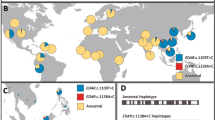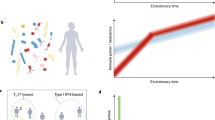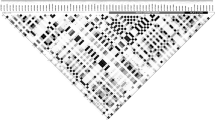Abstract
N-formylpeptides are phagocyte chemoattractants that act by binding to two structurally related receptors, FPR (formylpeptide receptor) and FPRL1R (FPR-like-1 receptor), which are encoded by the human genes FPR1 and FPRL1. Single nucleotide polymorphisms (SNPs) in the FPR coding region have been reported and two have been associated with the disease juvenile periodontitis; however, their frequency and linkage relationships are unknown. Here we systematically analyzed polymorphism in the open reading frames of FPR1 and FPRL1 by direct sequencing of cloned alleles from random blood donors from North America. For FPR1 we detected five non-synonymous SNPs and two synonymous SNPs in a sample of 26 chromosomes one each from 17 Caucasian and nine black random blood donors. Although all five non-synonymous SNPs were common in Caucasians, Blacks, and Asians, notable differences in allele frequency were found for each SNP in the different racial groups, suggesting differential selective pressures. We found that the FPR1 polymorphisms are linked in 15 common haplotypes. No polymorphisms were detected in FPRL1 after sampling 44 chromosomes from 36 random blood donors from the same three racial groups. Thus FPR1 and FPRL1, though they originated from a common gene, appear to have undergone markedly different evolutionary events.
This is a preview of subscription content, access via your institution
Access options
Subscribe to this journal
Receive 6 digital issues and online access to articles
$119.00 per year
only $19.83 per issue
Buy this article
- Purchase on Springer Link
- Instant access to full article PDF
Prices may be subject to local taxes which are calculated during checkout
Similar content being viewed by others
References
Rosenberg HF, Gallin JI Inflammation. In: Paul WE (ed). Fundamental Immunology Lippincott-Raven Publishers:Philadelphia 1999 pp 1051–1066
Zimmerman PA, Buckler-White A, Alkhatib G et al Inherited resistance to HIV-1 conferred by an inactivating mutation in CC chemokine receptor 5: studies in populations with contrasting clinical phenotypes, defined racial background, and quantified risk Mol Med 1997 3 23–36
Childs B, Moxon ER, Winkelstein JA Genetics and infectious diseases. In: King RA, Rotter JI, Motulsky AG (ed) The Genetic Basis of Common Diseases Oxford University Press: New York 1992 71–91
Gwinn MR, Sharma A, De Nardin E Single nucleotide polymorphisms of the N-formyl peptide receptor in localized juvenile periodontitis J Periodontol 1999 70 1194–201
Perez HD, Kelly E, Elfman F, Armitage G, Winkler J Defective polymorphonuclear leukocyte formyl peptide receptor(s) in juvenile periodontitis J Clin Invest 1991 87 971–976
Gao JL, Lee EJ, Murphy PM Impaired antibacterial host defense in mice lacking the N-formylpeptide receptor J Exp Med 1999 189 657–662
Perez HD, Holmes R, Kelly E, McClary J, Chou Q, Andrews WH Cloning of the gene coding for a human receptor for formyl peptides. Characterization of a promoter region and evidence for polymorphic expression Biochemistry 1992 31 11595–11599
Murphy PM, Tiffany HL, McDermott D, Ahuja SK Sequence and organization of the human N-formyl peptide receptor-encoding gene Gene 1993 133 285–290
Bao L, Gerard NP, Eddy RL Jr, Shows TB, Gerard C Mapping of genes for the human C5a receptor (C5AR), human FMLP receptor (FPR), and two FMLP receptor homologue orphan receptors (FPRH1, FPRH2) to chromosome 19 Genomics 1992 13 437–440
Boulay F, Tardif M, Brouchon L, Vignais P The human N-formylpeptide receptor. Characterization of two cDNA isolates and evidence for a new subfamily of G-protein-coupled receptors Biochemistry 1990 29 11123–11133
Gao JL, Becker EL, Freer RJ, Muthukumaraswamy N, Murphy PM A high potency nonformylated peptide agonist for the phagocyte N-formylpeptide chemotactic receptor J Exp Med 1994 180 2191–2197
Murphy PM, Ozcelik T, Kenney RT, Tiffany HL, McDermott D, Francke U A structural homologue of the N-formyl peptide receptor. Characterization and chromosome mapping of a peptide chemoattractant receptor family J Biol Chem 1992 267 7637–7643
Durstin M, Gao JL, Tiffany HL, McDermott D, Murphy PM Differential expression of members of the N-formylpeptide receptor gene cluster in human phagocytes Biochem Biophys Res Commun 1994 201 174–179
Yeagle PL, Danis C, Choi G, Alderfer JL, Albert AD Three dimensional structure of the seventh transmembrane helical domain of the G-protein receptor, rhodopsin Mol Vis 2000 6 125–131
Palczewski K, Kumasaka T, Hori T et al Crystal structure of rhodopsin: a G protein-coupled receptor Science 2000 289 739–745
Perez HD, Holmes R, Kelly E, McClary J, Andrews WH Cloning of a cDNA encoding a receptor related to the formyl peptide receptor of human neutrophils Gene 1992 118 303–304
Ye RD, Quehenberger O, Thomas KM et al The rabbit neutrophil N-formyl peptide receptor. c-DNA cloning, expression, and structure/function implications J Immunol 1993 150 1383–1394
Alvarez V, Coto E, Setien F, Gonzalez-Roces S, Lopez-Larrea C Molecular evolution of the N-formyl peptide and C5a receptors in non- human primates Immunogenetics 1996 44 446–452
Gao JL, Chen H, Filie JD, Kozak CA, Murphy PM Differential expansion of the N-formylpeptide receptor gene cluster in human and mouse Genomics 1998 51 270–276
Kumar S, Tamura K, Nei M Mega: molecular evolutionary genetics analysis software for microcomputers Comput Appl Biosci 1994 10 189–191
Cargill M, Altshuler D, Ireland J et al Characterization of single-nucleotide polymorphisms in coding regions of human genes Nat Genet 1999 22 231–238
Nei M, Li WH Mathematical model for studying genetic variation in terms of restriction endonucleases Proc Natl Acad Sci USA 1979 76 5269–5273
Halushka MK, Fan JB, Bentley K et al Patterns of single-nucleotide polymorphisms in candidate genes for blood-pressure homeostasis Nat Genet 1999 22 239–247
Murphy PM The N-formylpeptide chemotactic receptor. In: Horuk R (ed) Chemoattractant Ligands and their Receptors CRC Press: Boca Raton 1996 269–299
Murphy PM Molecular mimicry and the generation of host defense protein diversity [letter] Cell 1993 72 823–826
Zhang J, Rosenberg HF Sequence variation at two eosinophil-associated ribonuclease loci in humans Genetics 2000 156 1949–1958
Karlen A Man and Microbes: Disease and Plagues in History and Modern Times Putnam: New York 1995 pp 1–266
Mills JS, Miettinen HM, Cummings D, Jesaitis AJ Characterization of the binding site on the formyl peptide receptor using three receptor mutants and analogs of Met-Leu-Phe and Met-Met-Trp- Leu-Leu J Biol Chem 2000 275 39012–39017
Prossnitz ER, Kim CM, Benovic JL, Ye RD Phosphorylation of the N-formyl peptide receptor carboxyl terminus by the G protein-coupled receptor kinase, grk2 J Biol Chem 1995 270 1130–1137
Miettinen HM, Mills JS, Gripentrog JM, Dratz EA, Granger BL, Jesaitis AJ The ligand binding site of the formyl peptide receptor maps in the transmembrane region J Immunol 1997 159 4045–4054
Acknowledgements
We thank Dr George Zhang of the Laboratory of Host Defenses of the National Institute of Allergy and Infectious Disease of the National Institutes of Health, Bethesda, MD for helpful discussions regarding FPR evolution.
Author information
Authors and Affiliations
Corresponding author
Additional information
ASR is supported by a grant from the Pan-American Fellowship, US-Mexico Cooperative Biomedical and Behavioral Research Program (CoBRP), United States National Institutes of Health and Mexican National Council for Science and Technology (CONACYT).
Rights and permissions
About this article
Cite this article
Sahagun-Ruiz, A., Colla, J., Juhn, J. et al. Contrasting evolution of the human leukocyte N-formylpeptide receptor subtypes FPR and FPRL1R . Genes Immun 2, 335–342 (2001). https://doi.org/10.1038/sj.gene.6363787
Received:
Revised:
Accepted:
Published:
Issue Date:
DOI: https://doi.org/10.1038/sj.gene.6363787
Keywords
This article is cited by
-
Annexin A1 and its receptor gene polymorphisms in systemic lupus erythematosus in the Tunisian population
Clinical Rheumatology (2022)
-
FPR1 is the plague receptor on host immune cells
Nature (2019)
-
Haplosaurus computes protein haplotypes for use in precision drug design
Nature Communications (2018)
-
Preclinical evaluation of the urokinase receptor-derived peptide UPARANT as an anti-inflammatory drug
Inflammation Research (2017)
-
Congenital toxoplasmosis: candidate host immune genes relevant for vertical transmission and pathogenesis
Genes & Immunity (2010)



